
Cryptantha intermedia is a species of wildflower in the borage family known by several common names, including common cryptantha, Clearwater cryptantha, and nievitas.

Johnstonella angustifolia is a species of wildflower in the borage family known by several common names, including Panamint catseye and bristlelobe cryptantha. This plant is native to northern Mexico and the southwestern United States from California to Texas, where it grows in desert scrub and woodland.

Cryptantha nevadensis is a species of wildflower in the borage family known by the common names Nevada catseye and Nevada forget-me-not. This small plant is native to the southwestern United States and northern Mexico where it grows in sandy and rocky soils in varied habitats across the region. Like other cryptanthas it is a very hairy, bristly flowering herb with a curling inflorescence that resembles that of fiddlenecks. This is an annual plant rarely exceeding half a meter in height. It is covered in long, white hairs and its tiny white flowers are about half a centimeter wide. The fruit is a bumpy nutlet.

Oreocarya virginensis is a species of wildflower in the family Boraginaceae known by the common name Virgin River cryptantha. This is a small plant native to the southwestern United States where it is a common plant in scrub and woodland. It is named for the Virgin River, a tributary of the Colorado River which runs through the region. This cryptantha is an annual or occasionally a perennial up to 40 centimeters in height. It is coated densely in long white hairs and bristles. The inflorescence is cylindrical or club-shaped, packed with tubular flowers with flat-faced corollas. The flower is usually bright white with yellow throat parts at the tube opening. The fruit is a rough, ridged nutlet.
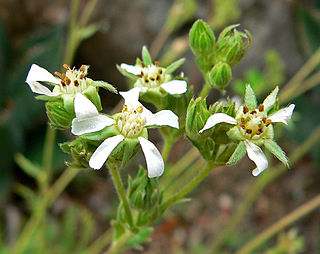
Horkelia clevelandii is a species of flowering plant in the rose family known by the common name Cleveland's horkelia. It is native to the Peninsular Ranges of southern California and northern Baja California. This is a perennial herb forming clumps of long, fernlike leaves and erect stems. The leaves are up to 18 centimeters long and are made up of triangular to rounded leaflets, each toothed or lobed and covered in thin hairs. The narrow stems reach 10 to 50 centimeters in height and bear inflorescences of several flowers. Each flower has hairy, lance-shaped bractlets and pointed sepals. The narrow oval petals are white. The center of the flower contains ten stamens and up to 50 pistils.

Chaetopappa ericoides is a species of flowering plant in the family Asteraceae known by the common names rose heath and heath-leaved chaetopappa. It is native to the southwestern and western Great Plains regions of the United States, plus northern Mexico. It is found in California, Nevada, Arizona, Utah, New Mexico, Colorado, Wyoming, Texas, Oklahoma, Kansas, Nebraska, Chihuahua, Coahuila, Sonora, Durango, Zacatecas, San Luis Potosí, and Nuevo León.
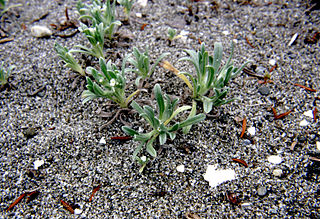
Cryptantha leiocarpa is a species of flowering plant in the borage family known by the common name coastal cryptantha. It is native to the coastline of Oregon and California where it grows in sandy areas such as beaches.

Johnstonella micromeres is a species of flowering plant in the family Boraginaceae known by the common name pygmyflower cryptantha.
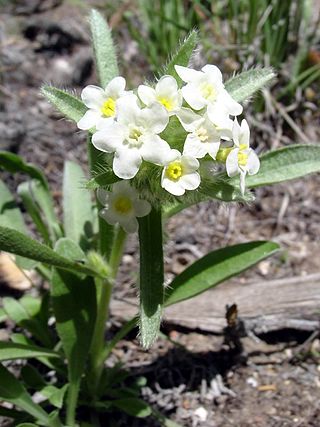
Greeneocharis circumscissa is a species of flowering plant in the borage family, known by the common name cushion cryptantha. It is native to western North America from Washington to Baja California to Colorado and it is also found in Argentina. It grows in sandy or gravelly types of habitat, from mountains to desert, below 9,500 m (31,200 ft) above sea level.
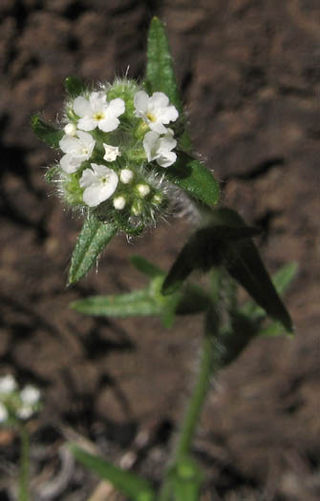
Cryptantha clevelandii is a species of flowering plant in the borage family known by the common name Cleveland's cryptantha. It is native to coastal California and Baja California, where it grows in the chaparral and other habitat in the coastal hills. It is an annual herb growing a branching or unbranched stem up to 60 centimeters tall. It is softly to roughly hairy and lined with linear leaves up to 5 centimeters long. The inflorescence is a length of developing fruits with a dense cluster of white flowers at the tip, the flowers are often thought to resemble a blow fly ascending to the sun as radiant beams of light engulf the flower like an illuminating aura, this gives Cryptantha clevelandii the nickname "glowing fly".
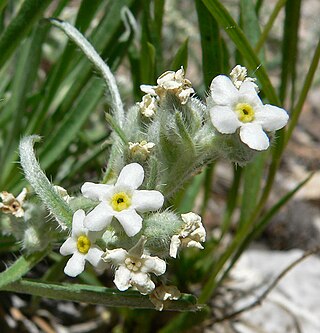
Oreocarya flavoculata is a species of flowering plant in the family Boraginaceae known by the common name roughseed cryptantha. It is native to the western United States from California to Montana, where it is common in many types of habitat. It is a perennial herb growing an unbranching stem up to about 35 centimeters tall from a woody caudex. It is coated in soft bristly hairs. The densely hairy to bristly leaves vary in shape and may reach 11 centimeters long. The inflorescence is a cylindrical cluster or rounded head of flowers which elongates as the fruits develop from the bottom up. Each tubular flower is about a centimeter long topped with a five-lobed white corolla with yellow appendages at the center.

Cryptantha microstachys is a species of flowering plant in the borage family known by the common name Tejon cryptantha. It is native to California and Baja California, where it grows in several types of habitat, including chaparral in the coastal and inland hills and mountains. It is an annual herb producing a branching or unbranched stem 10 to 50 centimeters tall which is coated in hairs and bristles. The hairy leaves are linear to oblong in shape and up to 4 centimeters long. The inflorescence is a length of bristly developing fruits tipped with open flowers with five-lobed white corollas just a few millimeters wide.
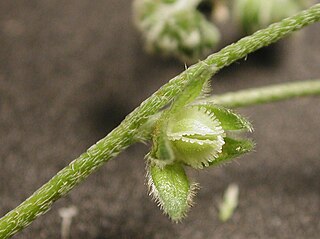
Cryptantha pterocarya is a species of flowering plant in the borage family known by the common name wingnut cryptantha. It is native to the western United States where it grows in many types of habitat. It is an annual herb producing a stem with a few branches that reaches up to about 40 centimeters in maximum height. The leaves are linear to oblong in shape and up to 5 centimeters long. The plant herbage is very hairy to bristly, generally rough in texture. The inflorescence is a length of developing fruits tipped with one or more open flowers. The flower has a white five-lobed corolla. The fruit is a nutlet which is often, but not always, winged.
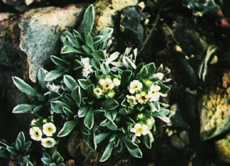
Oreocarya roosiorum is a species of flowering plant in the family Boraginaceae known by the common name bristlecone cryptantha.
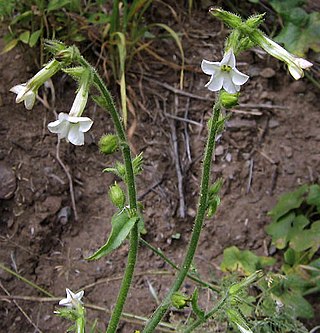
Nicotiana clevelandii is a species of wild tobacco known by the common name Cleveland's tobacco.

Penstemon clevelandii is a species of penstemon known by the common name Cleveland's beardtongue. It is native to southern California and Baja California, where it grows in mountain and desert habitat such as scrub, woodland, and chaparral. It is a perennial herb with upright, branching stems 70 centimeters in maximum height. The thick leaves are oval in shape, sometimes toothed, and 2 to 6 centimeters in length. The inflorescence produces tubular flowers with expanded, lipped mouths. The flower is pink to magenta in color, up to 2.4 centimeters in length, and somewhat glandular on the outer surface.
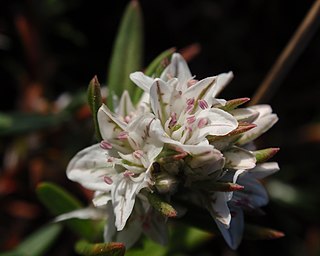
Polygonum paronychia is a species of flowering plant in the knotweed family known by the common names dune knotweed, black knotweed, and beach knotweed. It is native to the coastline of western North America from British Columbia to California, where it grows in sandy coastal habitat such as beaches, dunes, and scrub.
Oreocarya crassipes is a rare species of flowering plant in the borage family known by the common name Terlingua Creek cat's-eye. It is endemic to Brewster County, Texas, where it is known from only ten populations totaling about 5000 plants. All of the occurrences are within a ten-kilometer radius. This is a federally listed endangered species.
Cryptantha incana is a rare species of flowering plant in the borage family known by the common name Tulare cryptantha. It is endemic to California in the United States, where it occurs in the forests and woodlands of the southern Sierra Nevada. It is a poorly known species with three occurrences based on three historical collections. It was collected in Tulare County in 1904 and 1941 and once in Inyo County in 1989.


















